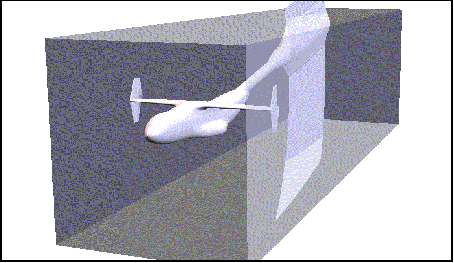Introduction
Advanced windtunnel testing of modern aircraft configurations calls for fast and effective data processing to allow to control and adjust the experiment while running. The experiments conducted on the DLR-F9 transport aircraft model aimed at investigations in the fuselage area involve a number of new technologies beyond the traditional well-known testing methods [1]. Such new approaches include an adaptive test section of the Transonic Windtunnel of DLR in Göttingen, an extremely large model with a high blockage ratio, and the use of Circulation Control Splitter Blades (CCSB) [2] for compensating for the cut-off wing tips.
Fig. 1 F9-Model in the windtunnel test section. CCSBs are fitted to the wings to correct for effects of model scale and clipped wings. The geometrical representation of the windtunnel which is shown here was also used for comparative numerical studies

This step into new areas of windtunnel testing requires the human in the loop in order to set model and windtunnel parameters in such a way that valid flow testing may be conducted. In order to support the decisions of the testing crew while the experiment is running, a fast run-time data processing and evaluation system was implemented which presents important evaluation of the measured data and feature extraction immediately after a set of data is sampled. This allows to minimize windtunnel testing time and ensure the quality of the experiments. Changes of the testing sequence or testing parameters are suggested while the experiment is running and may be entered on the fly into the windtunnel control system




